Deep Dive: The North Face vs. Patagonia Customers
Deep Dive: The North Face vs. Patagonia Customers
The competition between The North Face and Patagonia — the top two clothing brands dedicated to outfitting consumers for outdoor endurance sports, camping, fishing, surfing, mountain biking, and all activities of that sort — is a civil one. One company is the clear victor, in terms of dollars and cents, but the other doesn’t seem to mind that so much.
StatSocial is here to shine a light on the differences and/or similarities — in demographics, media affinities, favorite influencers, hobbies, personality traits, and Digital Tribe associations — between the most dedicated customers of each brand.
In this entry, StatSocial ’s one-of-a-kind customer insights — unlike those generated by any other tool on the market today — provide a completely unique, and utterly indispensable understanding of the relative strengths and appeals of both The North Face and Patagonia .
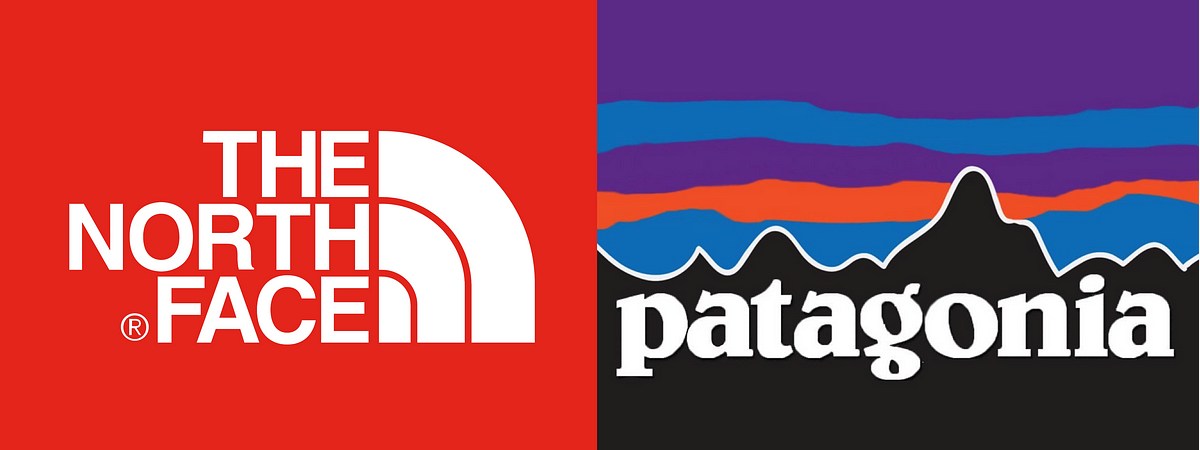
WHO WE ARE, WHAT WE KNOW
- StatSocial pulls in and compiles all available earned engagement data (meaning, what people read, like, follow, share, and talk about online) surrounding and/or involving any audience you can imagine.
- StatSocial ’s affinity datasets are culled from the individual profiles of over 500 million social media users. Our analysis considers over 85,000 unique attributes. As a result, we provide an in-depth breakdown of an audience’s passions, media preferences, influencers, personality traits, and Digital Tribes .
- To learn more, and to see more of our insights in action, you are always encouraged to reach to us for a demonstration , or in the meantime you can check out this audience comparison — where we a go a bit more in depth about things — here .
A BRIEF SUMMARY OF THE BRANDS
( If familiar, please feel free to scroll down to the section, “ AND NOW ONTO THE STATS ,” where the real reason we’ve gathered you here today is explored. )
- The North Face is the U.S. market leader in the outdoor clothing and accessories sector; pulling in more than $2 billion of the industry’s $4 billion annual earnings.
- The North Face co-founder Doug Tompkins opened his first shop — selling mountaineering gear — in San Francisco in 1966.
- During those mid-60s, San Francisco days, Tompkins became close friends with Patagonia founder, Yvon Chouinard; a fellow surfer and mountain climber.
- Around that same time, Tompkins began to sell Chouinard’s wares out of his shop. Their friendship now spans decades.
- As of the 21st century, Patagonia is The North Face ’s next closest competitor.
- While the number two company in the sector, Patagonia ’s yearly profits are in the (nothing to sneeze at, granted) hundreds of millions, as opposed to The North Face ’s billions.
- Patagonia, essentially, says that this is fine with them, as motives other than profits drive their business decisions.
Comparing the audiences of brands such as these two — those that are similar, possibly even indistinguishable to the passing observer — find us with a very cool opportunity to demonstrate the nuanced insights StatSocial provides.
The North Face and Patagonia sell the same kinds of products to ostensibly likeminded customers (with a not insignificant customer cross-over). There are, however, pronounced differences in how each company positions itself. Below, we set about seeing to what degrees these differences in stated philosophy, and overall messaging, are detectable among each brand’s consumers.
Patagonia has made their mission of running an environmentally and ethically sound business, no matter its impact on their bottom line, a top priority. This guiding principle is perhaps best summed up by the copy that accompanied what was essentially an anti-promotion on their website, which ran during the holidays some years back: “ We design and sell things made to last and be useful. But we ask our customers not to buy from us what you don’t need or can’t really use. Everything we make–everything anyone makes–costs the planet more than it gives back .”
While both brands serve the outdoor, endurance sport enthusiast, first and foremost, The North Face opts for a more rough and tumble, over-achiever, “ humanity against the elements, and itself ” branding (okay, we’ve taken the liberty to extrapolate a bit there). One of the athletes they sponsor, for example, is a man named Pete Athans; his claim to fame, among those who know of such things, is ascending Everest on seven separate occasions.
One of The North Face ’s slogans is “ never stop exploring ,” which is tough to argue with. The subtextual messaging imploring us to push ourselves to our limits, however, is more than faintly detectable. “ Extreme ” seems to have long ago fallen by the wayside of marketing jargon. Nonetheless, it comes to mind.
Patagonia ’s messaging also encourages the pushing of oneself to one’s limits, but it leaves room for communing with great wide open for its own sake. In their world, Mother Nature’s splendor is not merely what one seeks out when hankerin’ for insurmountable challenges to overcome. It is a glorious gift to be cherished, preserved, and appreciated.
Chouinard published a memoir in 2007 entitled ‘ Let My People Go Surfing: The Education of a Reluctant Businessman .’ In the book’s introduction he writes, “ I’ve been a businessman for almost 60 years. It’s as difficult for me to say those words as it is for someone to admit being an alcoholic or lawyer. ”
In recounting the outdoorsy youth that led him to the business he reluctantly concedes he runs, he said of his nascent adventuring “ We took special pride in the fact that climbing rocks and icefalls had no economic value in society .”
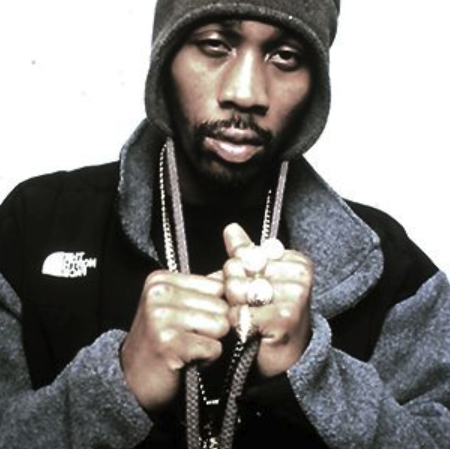
Selling gear that is professional grade to consumers whose motivations may run no deeper than looking good, staying warm, or having a sturdy, well-constructed duffel, is an impressive feat and a testament to the importance of both form and function.
High school kids keep their books in Patagonia backpacks, and starting in the 90s, and to this day, many famous rappers, as well as countless other Hip Hop enthusiasts, can be seen proudly donning one of The North Face ’s jackets; particularly those from the colorful Nuptse line.
The below results, though, reveal that there may be a fair deal more legitimately outdoorsy sorts buying the gear of both brands than you might think (oh, spoiler alert). They also may reveal if the differing corporate ethos, and company philosophies, appear to be shared by each brand’s most dedicated customers.
AND NOW ONTO THE STATS
An explanation of what you will see below : Each line item on the below lists has an accompanying percentage and index score . The former, as is plainly suggested, reports the actual, literal percentage of the audience who fit within the demographic, personality type, or Digital Tribe detailed in the lefthand column. The index score reports the degree to which that percentage either exceeds, falls short of, or is in line with the baseline being used to give these statistics context.
In the case of the below, we have used the average American online audience as our baseline.
GENDER

While both Patagonia and The North Face c ater to a not-insignificant quantity of female consumers, men confidently dominate the audiences of both brands.
With that obvious fact noted, it still bears mentioning that women account for 1.80% more of Patagonia ’s overall customer base.
AGE

Patagonia is notably stronger with younger consumers, finding a full 19.38% of their crowd between the ages of 18 and 24. This percentage exceeds what you’d find among the average U.S. online audience by 1.12 times .
Patagonia is strong with middle-aged users, as well, with over 43% of their enthusiasts being between ages 35 and 54 . The North Face , however, even more so attracts those age brackets. Nearly 47% of their consumers are between ages 35 and 54, with the portion between 35 and 44 being greater than our baseline by 1.14 time s, and the bunch between 45 and 54 exceeding what would be found within the average U.S. online audience 1.20 times.
BRANDS
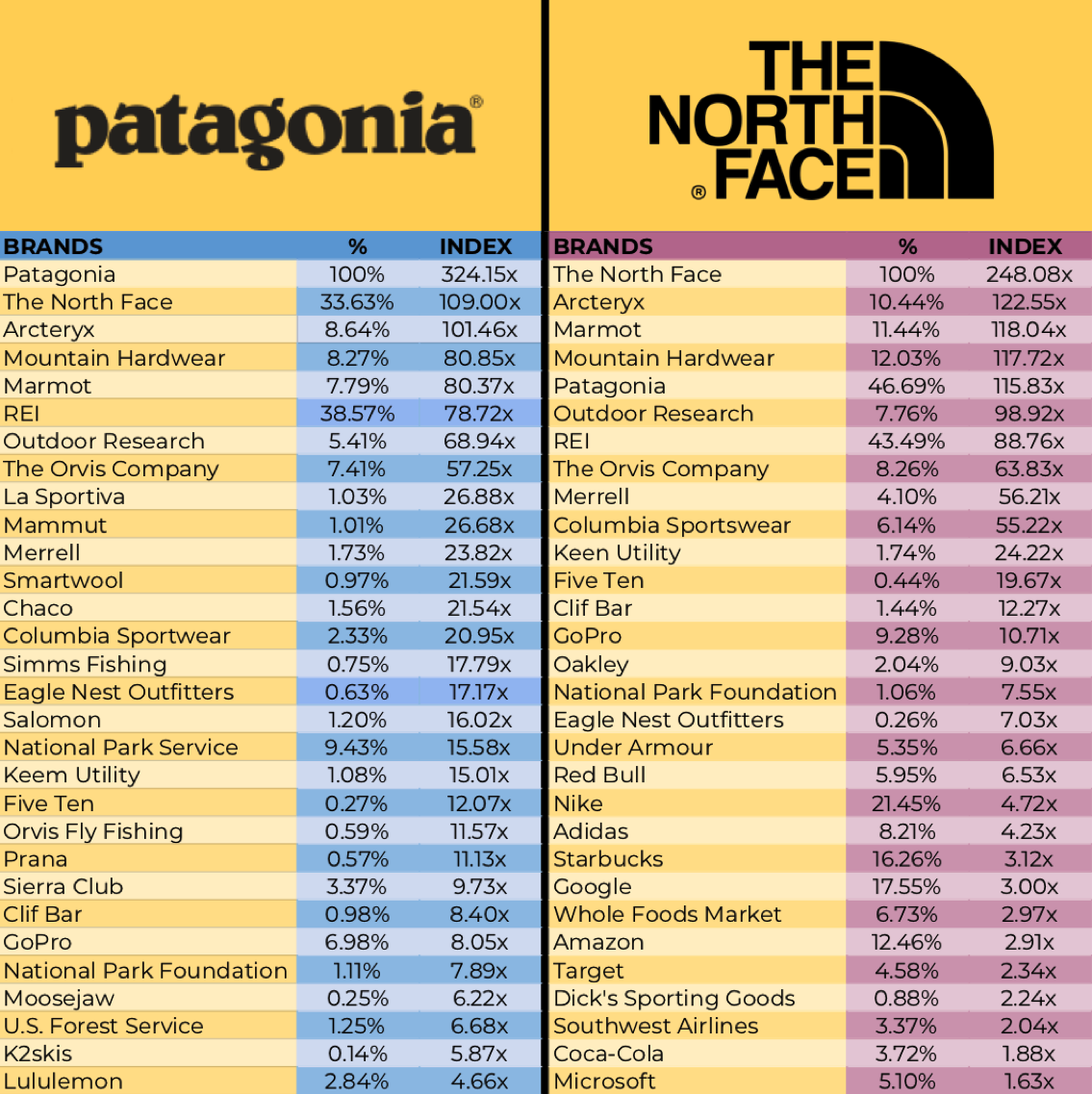
As will be true by necessity, each brand is appreciated by 100% of its own audience. What is interesting, though, is the audience overlap the above lists show.
The North Face is the second most over-indexed brand with Patagonia ’s customers. While Patagonia is the fifth most over-indexed among The North Face ’s throngs. All the same, a rather significant 46.69% of the The North Face audience are nonetheless faithful fans of both brands.
To really see where these audiences differ, we needed to share with you some longer lists of affinities. The two customer-bases are, after all, superficially quite alike, with the greatest immediately known difference being that The North Face boasts a larger collection of consumers.
For the first 15, or so, entries both lists look quite alike. Brands may hold different positions, but it’s brands of outdoor wear, sporting gear, and directly related products such as Clif Bar and GoPro cameras, charities such as The National Park Foundation (the official charity dedicated to the funding and upkeep of America’s over 400 stunning national parks).
Moving down the Patagonia list, things continue along these lines. Fishing, running, and biking brands, and environmental organizations such as the Sierra Club can be found without anything running contrary to what might be assumed.
The North Face ’s list, on the other hand, takes a decided turn. Not entirely away from fitness — at least not aggressively nor explicitly — but away from the chiefly outdoorsy and nature-focused. Nike, Target, Google, Coca-Cola, Microsoft , and other major corporations are all over-indexed, and favored by reasonably significant sized segments of this group of consumers.
INFLUENCERS
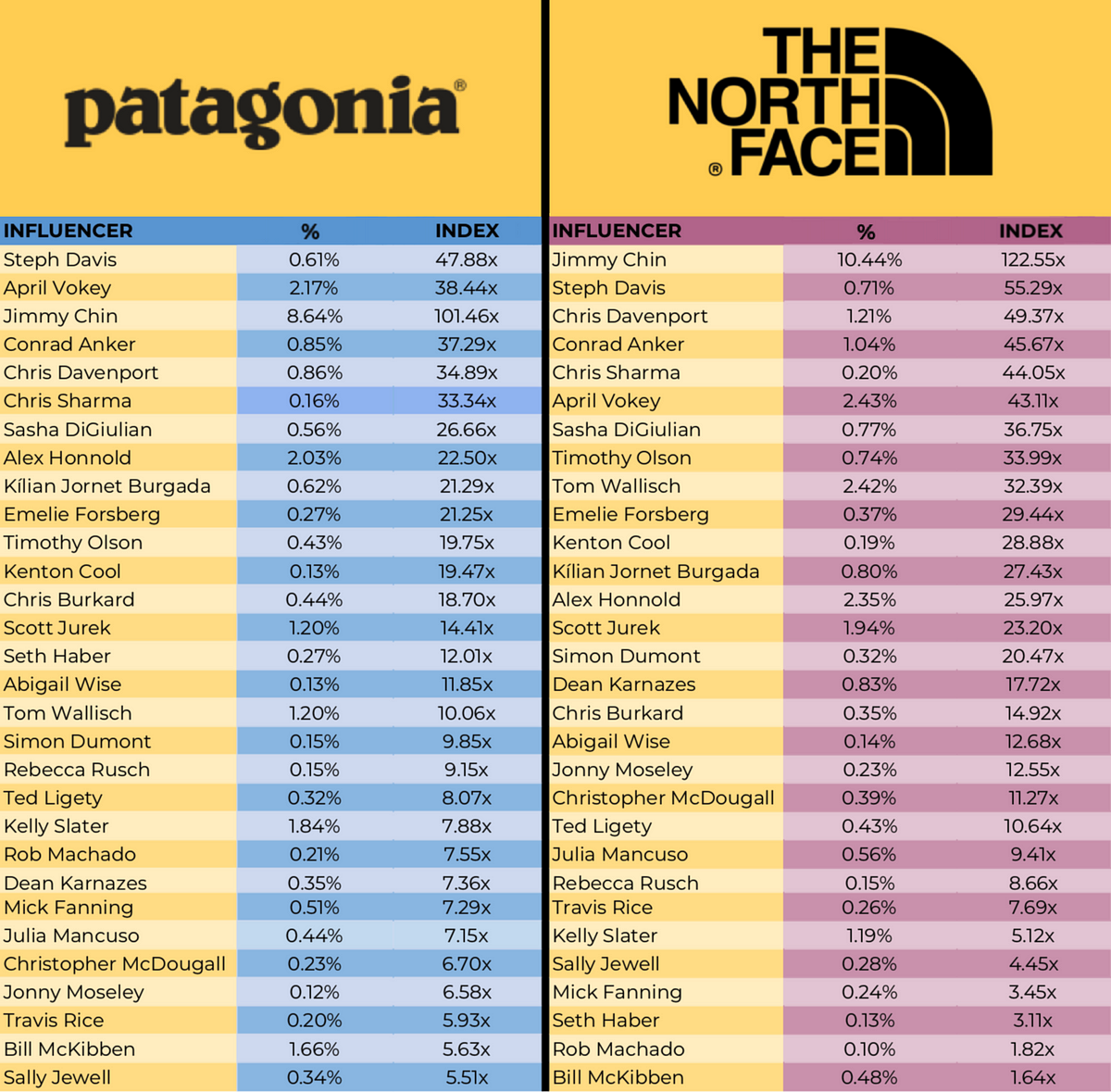
No matter the number of customers who have only ever seen a real mountain in photographs, this list of influencers suggests that the core of both brands’ customer-bases are no mere dilettantes.
When considering the above list of the 30 most highly-indexed influencers with each brand, no discernible difference is evident between the two audiences (digging further into these lists may reveal a point of divergence, but we’re afraid you’ll have to reach out to us for a demonstration to find out).
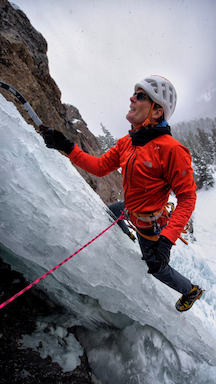
Let us walk you through: Steph Davis is a celebrated rock climber, April Vokey is a well-known fly-fisher and conservationist, Jimmy Chin is a professional rock climber, as is Conrad Anker. We could continue, but we assure you it goes on like this.
No musician, nor style icon, nor really any other manner of influencer to be found here. We suspect there’s a fair amount to be made of this, but for now we’ll leave you to make of it what you will.
MEDIA
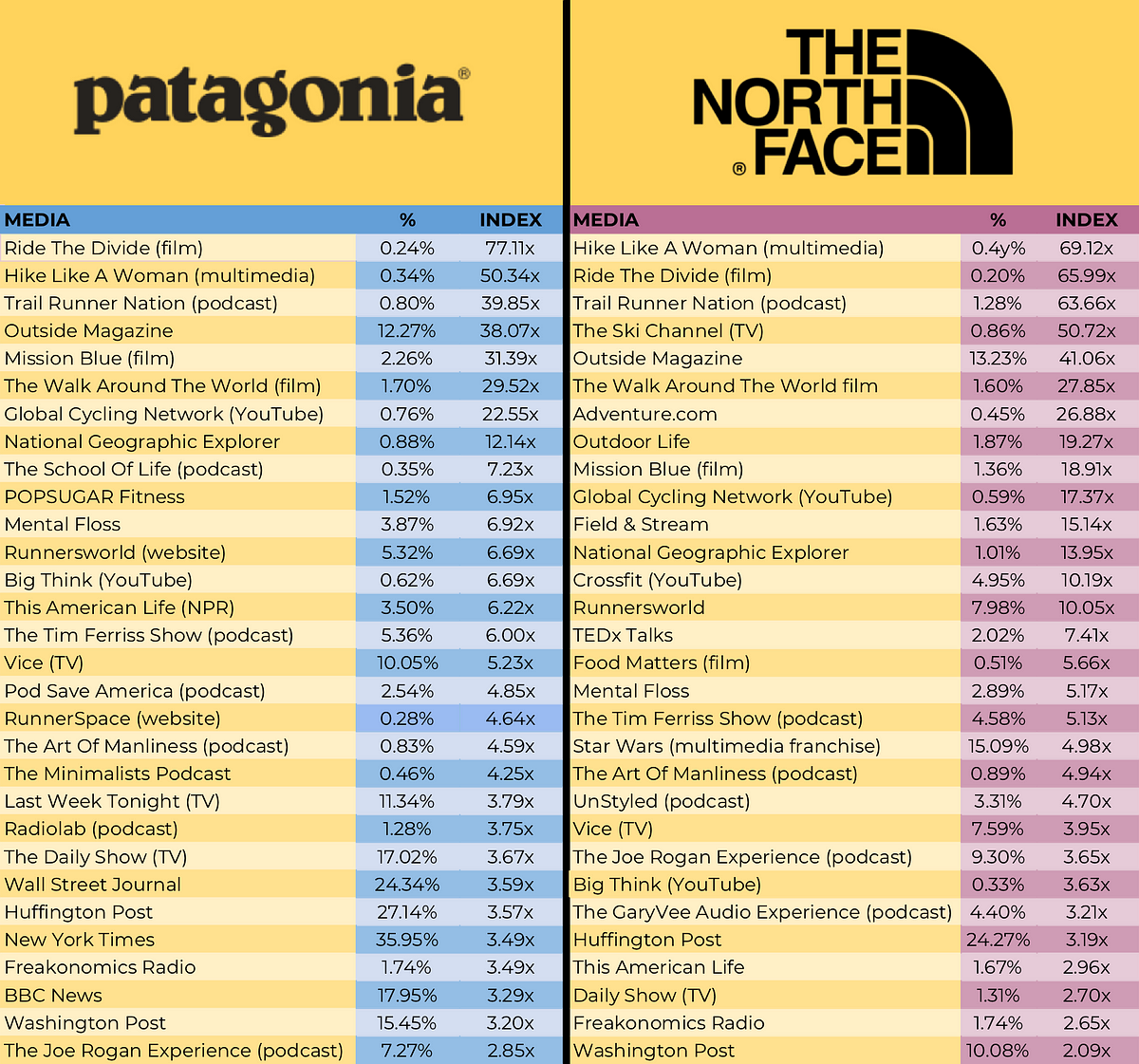
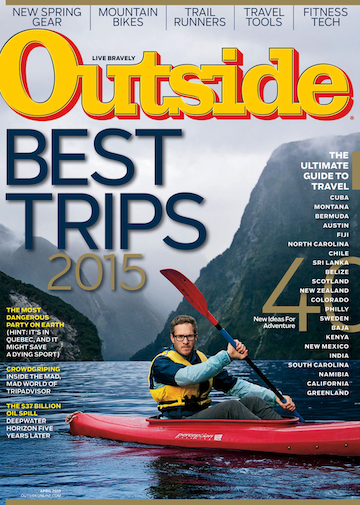
While as we descend the above lists, more standard fare peeks assorted heads in —such as ‘ This American Life ,’ ‘ Vice ,’ ‘ Radiolab ,’ and The New York Times — the initial batch of films, podcasts, YouTube channels, magazines, etc., closely adheres to the narrative(s) that suggests that the core consumers, of both brands, really do not only get off the couch, but also get out of the gym.
Or, at the very least the two are outdoorsy brands, catering to a variety of people (some, perhaps, indoorsy) who above all else engage with media that is about and/or revolves around outdoorsy things. As that sentence is a mouthful, and the whole idea is a fair bit to consider, the idea posited in this section’s opening paragraph may hold more water (much like the insulated bottles made by both of these brands).
Those items that are different between the two — ‘ BBC News ’ on the Patagonia side, ‘ Star Wars ’ on The North Face — could hint at the point where the differences between the audiences start to reveal themselves, but deeper digging would be necessary to know for certain. (And believe us, the data is there for the digging, should you be so curious .)
INTERESTS
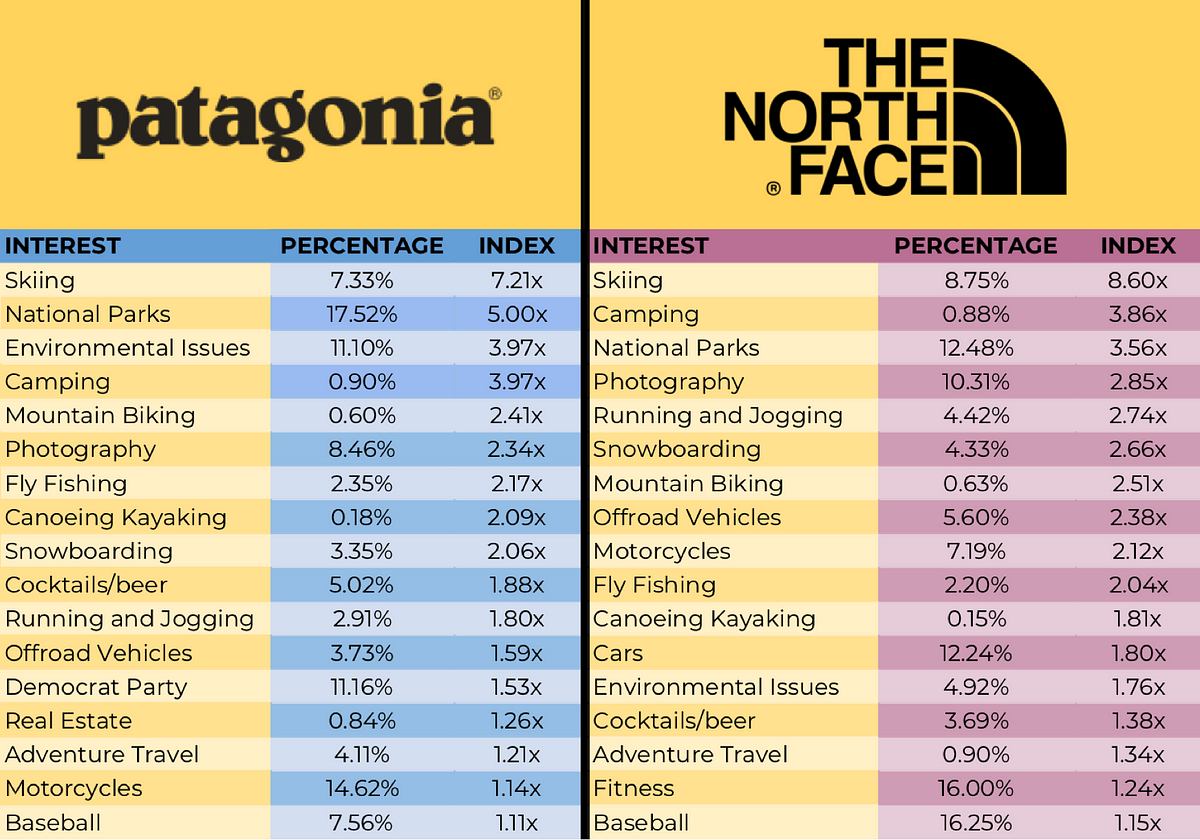
Both brands are outwardly environmentally conscious, but — as we went into above — Patagonia has made green concerns central to their brand to a degree that is seen by some as almost radical.
And here we have one more excellent illustration of how the deeper you dive into a StatSocial report, the more and more nuance you’re bound to uncover, as you become intimately acquainted with the audiences you’re researching.
What jumps out immediately looking at these lists side-by-side is that they are largely similar, but for one immediately evident difference in priorities. “ Environmental Issues ,” the heart of the Patagonia brand philosophy, rests in their lofty third place slot. But, looking at The North Face ’s list we notice that such concerns descend from that perch, all the way down to being 14th on the list. Beneath cars, motorcycles, offroad vehicles, and other perhaps “ less-than-green ” concerns.
Both audiences are interested in this variety of things, as well as most others listed here. It’s the questions of degrees and priorities where the differences are apparent.
DIGITAL TRIBES
StatSocial Digital Tribes is a model of the U.S. population broken down into 100 distinct market segments ( calculated by combining our demographic and affinity data with our Personality Insights ® data; the latter powered by IBM Watson ). Seeing which Tribes are present, and in what proportions, grants our users quick, crucial, and unprecedented insight into the humans who make up a given audience.
You can read more in depth descriptions of the Tribes mentioned below here , and you can read a blog entry going into the whole Digital Tribes matter a great deal more in-depth here .

The Digital Tribes whose members are most prevalent among each of these audiences suggest quite a few overlapping concerns, as you would expect given what we’ve learned so far. But the matter of degrees, most profoundly illustrated in the top interests we inspected above, does arise here as well.
With members of the politically leftist-oriented “ Left-Handed Smoke-Shifter, ” and the progressive “ A Leftward Slant ” Tribes very much present among these groups of consumers, politics appears to be a priority with both groups.
The members of these Tribes are clearly more present within the Patagonia audience. With 8% of their audience belonging to the “ Left-Handed Smoke-Shifter ” Tribe ( a percentage exceeding the baseline by 5.81 times ), the politics of the Patagonia audience seems to lean further to the left.
The weight-training oriented “ Do You Even Lift? ” lift Tribe —the third most represented among the Patagonia crowd, at 2.42% — tops out the most present Tribes among the The North Face crowd at a significant 4.02%
PERSONALITY TRAITS
Powered By IBM Watson Personality Insights™
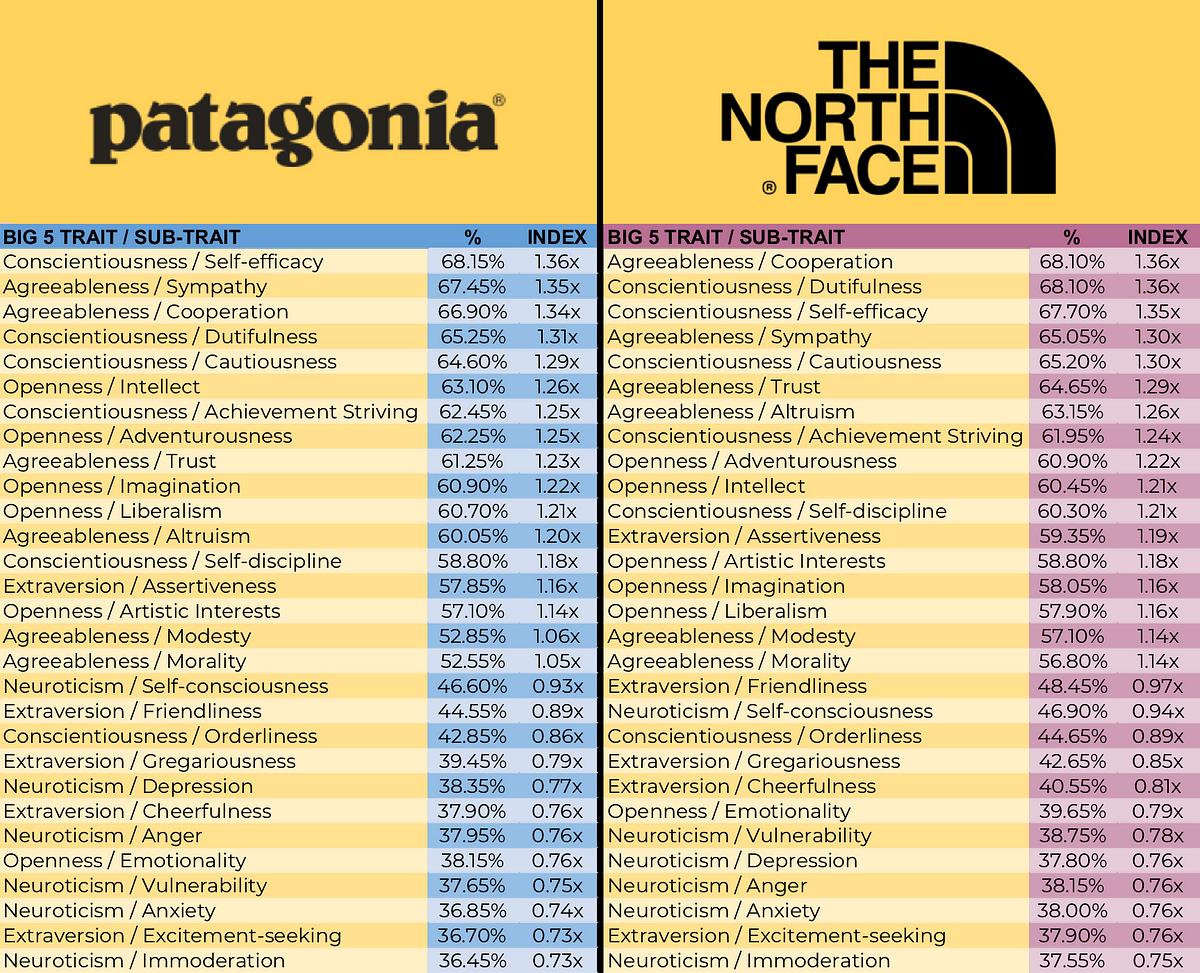
As these statistics are no small part of how we’ve grouped together our Digital Tribes , we do touch upon this above.
Among the many things StatSocial can teach you about any audience, one of the most revealing, and essential, is the breakdown of the various personality types that can be found among the bunch being explored.
Thanks to StatSocial ’s partnership with IBM Watson™ and the integration of their Personality Insights™ service into our reporting we can report on personality traits with as much confidence as we do those metrics which, to some, might seem more concrete.
As mentioned above, the data StatSocial uses to calculate its insights is pulled in from the web’s many far flung nooks and crannies. This includes social media postings, blog entries, articles, message board posts, and all writings each audience’s member has posted.
Watson ’s sophisticated AI allows IBM Watson Personality Insights ™ to analyze these postings and infer from the language and tone used — with extraordinary accuracy — the personality types of those behind the communications. To learn more, we encourage you to visit IBM Watson’s site here.
For this example, we decided to sort each audience individually, and give the full side-by-side comparison of each audience’s most prominent personality types. We invite you to scrutinize the above yourselves, and see what may leap out at you as extraordinary, or even simply curious.
— — — — — — —
INTERESTED TO LEARN A LOT MORE?
We encourage you to reach out, so we can schedule a time to chat .
More information on our data can be found here .
And the links below provide information on a variety of the solutions we provide:
To request a full-on demo, click here .